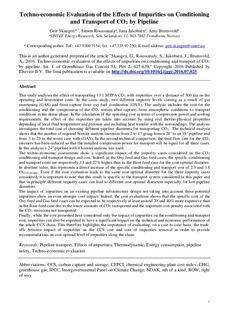| dc.contributor.author | Skaugen, Geir | |
| dc.contributor.author | Roussanaly, Simon | |
| dc.contributor.author | Jakobsen, Jana Poplsteinova | |
| dc.contributor.author | Brunsvold, Amy | |
| dc.date.accessioned | 2017-07-06T12:24:10Z | |
| dc.date.available | 2017-07-06T12:24:10Z | |
| dc.date.created | 2016-09-26T13:58:19Z | |
| dc.date.issued | 2016 | |
| dc.identifier.citation | International Journal of Greenhouse Gas Control. 2016, 54 (2), 627-639. | nb_NO |
| dc.identifier.issn | 1750-5836 | |
| dc.identifier.uri | http://hdl.handle.net/11250/2448080 | |
| dc.description.abstract | This paper describes a detailed technical and economic assessment of conditioning and transporting 13.1 MTPA CO2 with impurities in an on-shore pipe-line over a distance of 500 km. The impurities that are included in the study represents 5 mol% residuals from air-components (N2 and O2) and 10 mol% residuals from natural gas components (N2 and CH4). The analysis includes compression from low pressure, after the captures process, to the pipeline conditions in the dense phase of 150 bar. In the technical analysis of the pipeline transport, thermo-physical properties depending of the pressure and temperature locally as the stream evolves through the pipeline are used as well as heat transferred with the surroundings. The case studies investigate different pipeline diameters from 18″ to 28″ to find the most economical pipeline diameter for each impurity level. The cost model includes the material, labour and energy costs and the result are dependent on the number of required, booster stations, the pipeline wall thickness, the energy consumption and cooling demand. The wall thicknesses are chosen for each investigated diameter based on strength design and rounded off to the next available standard wall thickness according to the API-standard. In the second part, a 24″ pipeline with 4 booster stations is selected and the feed flow rate has been adjusted to match the installed compression power. The results show that for the cost-optimal diameter the specific conditioning and transport cost increases by 13 and 22% for the two cases compared to transporting pure CO2. This represents an increase from 2.3 to 3.8 €/tonCO2. The second scenario, where impure CO2 is transported in an existing pipeline, the cost is shown to be around 20–40% more expensive than transporting pure CO2. The effect on energy consumption and cost from different ambient conditions are also discussed and it is shown that for the selected case the cost of transport will vary 0.01 €/ton/K with change in average temperature from 15 °C as the baseline. Impurities can also be expected to have a significant impact on the technical and economic performances of the whole CCS chain and it is therefore important to evaluate this on a case-to-case bases in order to find possible trade-offs between capture, conditioning, transport and storage and to provide recommendations. | nb_NO |
| dc.language.iso | eng | nb_NO |
| dc.publisher | Elsevier | nb_NO |
| dc.rights | Navngivelse 4.0 Internasjonal | * |
| dc.rights.uri | http://creativecommons.org/licenses/by/4.0/deed.no | * |
| dc.title | Techno-economic evaluation of the effects of impurities on conditioning and transport of CO2 by pipeline | nb_NO |
| dc.type | Journal article | nb_NO |
| dc.type | Peer reviewed | nb_NO |
| dc.description.version | submittedVersion | nb_NO |
| dc.rights.holder | Authors have copyright to preprint Version. | nb_NO |
| dc.source.pagenumber | 627-639 | nb_NO |
| dc.source.volume | 54 | nb_NO |
| dc.source.journal | International Journal of Greenhouse Gas Control | nb_NO |
| dc.source.issue | 2 | nb_NO |
| dc.identifier.doi | 10.1016/j.ijggc.2016.07.025 | |
| dc.identifier.cristin | 1385674 | |
| dc.relation.project | EU/308809 | nb_NO |
| cristin.unitcode | 7548,60,0,0 | |
| cristin.unitname | Gassteknologi | |
| cristin.ispublished | true | |
| cristin.fulltext | preprint | |
| cristin.qualitycode | 2 | |

